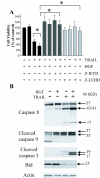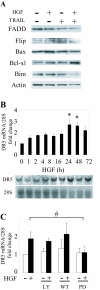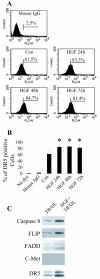Hepatocyte growth factor enhances death receptor-induced apoptosis by up-regulating DR5
- PMID: 18992144
- PMCID: PMC2590617
- DOI: 10.1186/1471-2407-8-325
Hepatocyte growth factor enhances death receptor-induced apoptosis by up-regulating DR5
Abstract
Background: Hepatocyte growth factor (HGF) and its receptor c-MET are commonly expressed in malignant gliomas and embryonic neuroectodermal tumors including medulloblastoma and appear to play an important role in the growth and dissemination of these malignancies. Dependent on cell context and the involvement of specific downstream effectors, both pro- and anti-apoptotic effects of HGF have been reported.
Methods: Human medulloblastoma cells were treated with HGF for 24-72 hours followed by death receptor ligand TRAIL (Tumor necrosis factor-related apoptosis-inducing ligand) for 24 hours. Cell death was measured by MTT and Annexin-V/PI flow cytometric analysis. Changes in expression levels of targets of interest were measured by Northern blot analysis, quantitative reverse transcription-PCR, Western blot analysis as well as immunoprecipitation.
Results: In this study, we show that HGF promotes medulloblastoma cell death induced by TRAIL. TRAIL alone triggered apoptosis in DAOY cells and death was enhanced by pre-treating the cells with HGF for 24-72 h prior to the addition of TRAIL. HGF (100 ng/ml) enhanced TRAIL (10 ng/ml) induced cell death by 36% (P<0.001). No cell death was associated with HGF alone. Treating cells with PHA-665752, a specific c-Met receptor tyrosine kinase inhibitor, significantly abrogated the enhancement of TRAIL-induced cell death by HGF, indicating that its death promoting effect requires activation of its canonical receptor tyrosine kinase. Cell death induced by TRAIL+HGF was predominately apoptotic involving both extrinsic and intrinsic pathways as evidenced by the increased activation of caspase-3, 8, 9. Promotion of apoptosis by HGF occurred via the increased expression of the death receptor DR5 and enhanced formation of death-inducing signal complexes (DISC).
Conclusion: Taken together, these and previous findings indicate that HGF:c-Met pathway either promotes or inhibits medulloblastoma cell death via pathway and context specific mechanisms.
Figures






Similar articles
-
The scatter factor/hepatocyte growth factor: c-met pathway in human embryonal central nervous system tumor malignancy.Cancer Res. 2005 Oct 15;65(20):9355-62. doi: 10.1158/0008-5472.CAN-05-1946. Cancer Res. 2005. PMID: 16230398
-
Reactivation of death receptor 4 (DR4) expression sensitizes medulloblastoma cell lines to TRAIL.J Neurooncol. 2009 Jul;93(3):303-18. doi: 10.1007/s11060-008-9788-x. Epub 2009 Jan 16. J Neurooncol. 2009. PMID: 19148581 Free PMC article.
-
Capsaicin sensitizes malignant glioma cells to TRAIL-mediated apoptosis via DR5 upregulation and survivin downregulation.Carcinogenesis. 2010 Mar;31(3):367-75. doi: 10.1093/carcin/bgp298. Epub 2009 Nov 25. Carcinogenesis. 2010. PMID: 19939880
-
Biochemical analysis of the native TRAIL death-inducing signaling complex.Methods Mol Biol. 2008;414:221-39. doi: 10.1007/978-1-59745-339-4_16. Methods Mol Biol. 2008. PMID: 18175822 Review.
-
Playing the DISC: turning on TRAIL death receptor-mediated apoptosis in cancer.Biochim Biophys Acta. 2010 Apr;1805(2):123-40. doi: 10.1016/j.bbcan.2009.11.004. Epub 2009 Dec 2. Biochim Biophys Acta. 2010. PMID: 19961901 Review.
Cited by
-
Krüppel-like factor 9 and histone deacetylase inhibitors synergistically induce cell death in glioblastoma stem-like cells.BMC Cancer. 2018 Oct 22;18(1):1025. doi: 10.1186/s12885-018-4874-8. BMC Cancer. 2018. PMID: 30348136 Free PMC article.
-
Analysis of KLF4 regulated genes in cancer cells reveals a role of DNA methylation in promoter- enhancer interactions.Epigenetics. 2018;13(7):751-768. doi: 10.1080/15592294.2018.1504592. Epub 2018 Aug 25. Epigenetics. 2018. PMID: 30058478 Free PMC article.
-
Transcriptomics Based Network Analyses and Molecular Docking Highlighted Potentially Therapeutic Biomarkers for Colon Cancer.Biochem Genet. 2023 Aug;61(4):1509-1527. doi: 10.1007/s10528-023-10333-9. Epub 2023 Jan 16. Biochem Genet. 2023. PMID: 36645555
-
Kaempferol Induces G2/M Cell Cycle Arrest via Checkpoint Kinase 2 and Promotes Apoptosis via Death Receptors in Human Ovarian Carcinoma A2780/CP70 Cells.Molecules. 2018 May 5;23(5):1095. doi: 10.3390/molecules23051095. Molecules. 2018. PMID: 29734760 Free PMC article.
-
Targeting c-Met receptor overcomes TRAIL-resistance in brain tumors.PLoS One. 2014 Apr 18;9(4):e95490. doi: 10.1371/journal.pone.0095490. eCollection 2014. PLoS One. 2014. PMID: 24748276 Free PMC article.
References
Publication types
MeSH terms
Substances
Grants and funding
LinkOut - more resources
Full Text Sources
Other Literature Sources
Research Materials
Miscellaneous

